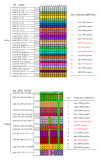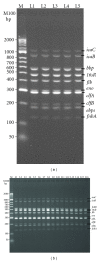Prevalence of adhesion and regulation of biofilm-related genes in different clones of Staphylococcus aureus
- PMID: 22701309
- PMCID: PMC3372070
- DOI: 10.1155/2012/976972
Prevalence of adhesion and regulation of biofilm-related genes in different clones of Staphylococcus aureus
Abstract
Clinical information about genotypically different clones of biofilm-producing Staphylococcus aureus is largely unknown. We examined whether different clones of methicillin-sensitive and methicillin-resistant S. aureus (MSSA and MRSA) differ with respect to staphylococcal microbial surface components recognizing adhesive matrix molecules (MSCRAMMs) in biofilm formation. The study used 60 different types of spa and determined the phenotypes, the prevalence of the 13 MSCRAMM, and biofilm genes for each clone. The current investigation was carried out using a modified Congo red agar (MCRA), a microtiter plate assay (MPA), polymerase chain reaction (PCR), and reverse transcriptase polymerase chain reaction (RT-PCR). Clones belonging to the same spa type were found to have similar properties in adheringto the polystyrene microtiter plate surface. However, their ability to produce slime on MCRA medium was different. PCR experiments showed that 60 clones of MSSA and MRSA were positive for 5 genes (out of 9 MSCRAMM genes). icaADBC genes were found to be present in all the 60 clones tested indicating a high prevalence, and these genes were equally distributed among the clones associated with MSSA and those with MRSA. The prevalence of other MSCRAMM genes among MSSA and MRSA clones was found to be variable. MRSA and MSSA gene expression (MSCRAMM and icaADBC) was confirmed by RT-PCR.
Figures




References
-
- Costerton JW, Stewart PS, Greenberg EP. Bacterial biofilms: a common cause of persistent infections. Science. 1999;284(5418):1318–1322. - PubMed
-
- Seo YS, Lee DY, Rayamahji N, Kang ML, Yoo HS. Biofilm-forming associated genotypic and phenotypic characteristics of Staphylococcus spp. Isolated from animals and air. Research in Veterinary Science. 2008;85(3):433–438. - PubMed
-
- Chaieb K, Mahdouani K, Bakhrouf A. Detection of icaA and icaD loci by polymerase chain reaction and biofilm formation by Staphylococcus epidermidis isolated from dialysate and needles in a dialysis unit. Journal of Hospital Infection. 2005;61(3):225–230. - PubMed
Publication types
MeSH terms
LinkOut - more resources
Full Text Sources
Medical
Molecular Biology Databases

